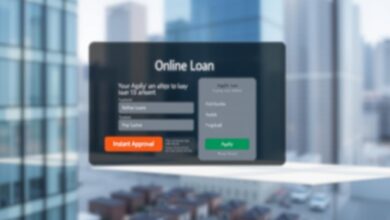Secure Personal Loans for Your Financial Needs
Did you know nearly 20% of Americans face financial emergencies each year? Often, they need money right away. Secure personal loans can help in such situations.
Financial needs can pop up unexpectedly. Having a reliable financial safety net is key. A secured loan lets you borrow money by using something valuable as collateral. This could be a car or savings account.
By offering collateral, you make it easier for lenders to trust you. This can lead to better loan terms. It’s a way to handle financial emergencies and even boost your credit score.
Key Takeaways
- Secure personal loans require collateral, reducing lender risk.
- These loans can offer more favorable terms due to the reduced risk.
- Using a secured loan can help manage financial emergencies.
- Collateral can be a vehicle, savings account, or other valuable assets.
- Repaying a secured loan can help build or improve your credit score.
What are Personal Loans?
Personal loans are a big deal in personal finance. They give people money for many needs, like paying off debt or fixing up their homes.
Definition of Personal Loans
Personal loans come from banks, credit unions, or online lenders. They have a set amount, interest rate, and time to pay back. Personal loans can be secured or unsecured. Secured loans need something valuable as collateral. Unsecured loans don’t need collateral but might have higher rates or stricter rules.
Types of Personal Loans
There are many personal loans for different needs. Here are a few:
- Unsecured personal loans, which don’t need collateral.
- Secured personal loans, which need collateral like a car or savings.
- Debt consolidation loans, to merge multiple debts into one with a lower rate and one payment.
- Payday loans, short-term loans due on the next payday.
Knowing these types helps borrowers pick the right one for them.
How Personal Loans Work
Getting a personal loan involves a few steps. First, you apply by sharing personal and financial details. The lender checks your credit score and history. If you’re approved, you get the money and agree to pay it back, with interest and fees, over time.
Benefits of Personal Loans
Personal loans have many advantages. They are a flexible and often cheaper way to meet financial needs.
Quick Access to Funds
One big benefit of personal loans is getting money fast. When you need cash quickly, personal loans can be a lifesaver. Many lenders, like those offering online personal loans, make the process fast. This means you can get your money quickly.
Flexibility in Use
Personal loans are very flexible. You can use them for many things, like paying off debt or fixing your home. This makes them a great choice for many people.
Potential for Lower Interest Rates
Secured personal loans can have low interest rates. This is because they are backed by something valuable. This makes lenders more likely to offer good rates. So, you can pay back less money over time.
Personal loans are a popular choice for many. They offer quick access to cash, flexibility, and the chance for lower interest rates. They are a valuable financial tool.
Factors to Consider Before Applying
Before applying for a personal loan, it’s important to think about several key points. Lenders look at many parts of your financial life to decide if they can lend to you.
Credit Score Importance
Your credit score is very important. It affects the interest rate you get and if you’ll get the loan. A good credit score means you’re seen as a reliable borrower. This can lead to better loan deals.
For example, a score of 750 or more is considered good. It can help you get lower interest rates and better loan offers.
To boost your credit score, focus on:
- Paying your bills on time
- Reducing your debt-to-income ratio
- Avoiding new credit inquiries
Loan Amount and Term
Knowing the loan amount and term is key. The loan should meet your needs without being too much. The repayment term should fit your budget.
A longer term means lower monthly payments. But, it can also mean paying more interest over time.
When choosing the loan amount and term, think about:
- The total cost of the loan
- Your monthly budget and expenses
- The impact on your credit utilization ratio
Interest Rates and Fees
Interest rates and fees for personal loans can differ a lot. It’s crucial to understand the Annual Percentage Rate (APR). This includes both the interest and fees to know the loan’s full cost.
When looking at interest rates and fees, consider:
- The difference between fixed and variable interest rates
- Origination fees and other charges
- Potential penalties for late payments
By carefully looking at these factors, you can make a better choice when applying for a personal loan. This ensures you get the best terms for your financial situation.
How to Apply for a Personal Loan
To apply for a personal loan, follow a clear plan. We’ll show you how to make the process easy and smooth.
Research Lenders and Options
Start by looking at different lenders. Compare their rates, terms, and what they need from you. Choose a lender that fits your financial situation. If your credit isn’t perfect, look for personal loans for bad credit.
Gather Necessary Documentation
After picking lenders, get your documents ready. You’ll need proof of income, ID, and sometimes collateral. Having everything ready makes the process faster. Check with your lender for specific needs.
Online vs. In-Person Applications
You can apply online or in person, depending on the lender. Online applications are quick and easy. In-person applications offer a personal touch. Think about what you prefer and what the lender offers.
Financial experts say, “Preparation and knowing what lenders want is key.” This shows how important research and being ready are.
“Understanding your financial needs and choosing the right loan product can make a significant difference in your borrowing experience.”
Understanding Interest Rates
It’s important to know how interest rates work if you’re getting a personal loan. The rates can change the loan’s total cost. So, it’s key to understand the types and how they’re set.
Fixed vs. Variable Rates
When you apply for a personal loan, you must choose between fixed and variable rates. A fixed interest rate stays the same, making your payments predictable. But, a variable interest rate can change with the market, affecting your payments.
Here are some main differences:
- Predictability: Fixed rates keep payments steady, while variable rates can vary.
- Initial Rates: Variable rates might start lower but can rise over time.
- Risk Tolerance: Those who like stability might choose fixed rates. Others might prefer variable rates if they can handle changes.
How Interest Rates Are Determined
Several things decide personal loan interest rates. These include the lender’s policies, market conditions, and your credit score. Lenders use these to figure out the risk and set the rate.
Impact of Your Credit Score
Your credit score greatly affects your interest rate. A better score means you’re seen as less risky, leading to lower rates. A lower score might mean higher rates because you’re seen as riskier.
Here’s how credit scores can influence rates:
| Credit Score Range | Typical Interest Rate |
|---|---|
| 750+ | 6%-8% |
| 700-749 | 8%-12% |
| 650-699 | 12%-15% |
Keeping a good credit score is vital for getting better rates on your loan.
Common Uses for Personal Loans
Looking to consolidate debt or finance a home improvement? Personal loans can help. They offer a flexible way to meet various financial needs.
Debt Consolidation
Debt consolidation is a common use for personal loans. It simplifies your finances by combining multiple debts into one. This can lower your monthly payments, which is great for those with high-interest credit card debt. Experian notes that it can save on interest and make managing your finances easier.
Home Improvement Projects
Personal loans are also good for home improvement projects. They can fund renovations, updates, or value-boosting improvements. Getting a personal loan for these can be wise, as it may increase your home’s value and improve your life.

Emergency Expenses
Personal loans can be a lifeline for emergency expenses. They help cover unexpected costs like medical bills or car repairs. This way, you can manage these expenses and get back on track financially.
| Use Case | Benefits | Considerations |
|---|---|---|
| Debt Consolidation | Simplifies finances, potentially lowers monthly payments | May require a good credit score, potential for higher total interest |
| Home Improvement Projects | Increases home value, enhances living space | Project costs can be difficult to predict, potential for overspending |
| Emergency Expenses | Provides quick access to funds, helps manage unexpected costs | Interest rates can be high, repayment terms may be strict |
Understanding personal loans’ common uses helps us make better borrowing decisions. Whether for debt consolidation, home improvements, or emergencies, personal loans offer a flexible financial solution.
Personal Loan vs. Credit Cards
Choosing between a personal loan and a credit card depends on several factors. These include interest rates, credit limits, and repayment terms. It’s important to understand how these two financial tools differ.
Differences in Interest Rates
Personal loans and credit cards have different interest rates. Personal loans often have fixed interest rates, making monthly payments predictable. Credit cards, on the other hand, have variable interest rates that can change based on market conditions.
For example, personal loan interest rates can range from 6% to 36% APR. Credit card rates can be between 12% to over 25% APR. Some credit cards even offer 0% introductory APRs for a promotional period.
Credit Limits and Accessibility
Credit limits and accessibility are key factors to consider. Personal loans give you a lump sum to repay over a fixed term. Credit cards, on the other hand, offer a revolving line of credit that you can use, repay, and reuse.
Personal loans can range from a few thousand dollars to $100,000 or more. Credit card limits vary, from a few hundred to several thousand dollars, based on the issuer and your credit profile.
Repayment Terms
Repayment terms differ between personal loans and credit cards. Personal loans have fixed repayment terms, from a few months to several years, with equal monthly payments. Credit cards require a minimum monthly payment, leading to a longer payoff period if you only pay the minimum.
| Feature | Personal Loans | Credit Cards |
|---|---|---|
| Interest Rates | Fixed, 6% to 36% APR | Variable, 12% to 25%+ APR |
| Credit Limit | Lump sum, up to $100,000+ | Revolving, few hundred to several thousand |
| Repayment Terms | Fixed, few months to several years | Minimum payment, variable payoff period |
The Application Process Explained
Applying for a personal loan can seem tough. But knowing the steps can make it easier.
The first step is a step-by-step application. You’ll share personal and financial details with the lender.
Step-by-Step Guide to Applying
The process starts with an online or in-person form. You’ll need to provide income proof, ID, and credit history.
- Fill out the application form accurately.
- Provide required documentation.
- Submit your application for review.
What to Expect During Approval
After you apply, the lender checks your creditworthiness. They look at your credit score, income, and debt-to-income ratio.
The approval process can vary in length. It depends on the lender and your application’s complexity. Some offer instant approval, while others take days.
| Approval Stage | Typical Timeframe | Factors Considered |
|---|---|---|
| Initial Review | 1-3 days | Credit score, income |
| Detailed Assessment | 3-7 days | Debt-to-income ratio, credit history |
| Final Approval | 1-2 days | Overall creditworthiness |
Timeline for Receiving Funds
After approval, you’ll get your funds in a few business days. The exact time depends on the lender and your bank.
Knowing the application process helps you prepare. It makes informed decisions about your personal loan easier.
Tips for Getting Approved
To boost your chances of getting a secured personal loan, knowing what lenders want is key. They look at your credit score, debt-to-income ratio, and how steady your income is.
Improving Your Credit Score
Your credit score is very important for lenders. A better score means you’re less risky. To up your score, pay bills on time, cut down debt, and limit new credit checks.
For example, paying off what you owe and keeping credit use under 30% can really help. Also, check your credit report often and fix any mistakes you find.

Reducing Debt-to-Income Ratio
Lenders also check your debt-to-income ratio. This is how much you owe each month compared to your income. To lower this ratio, pay off debts with high interest and don’t take on more debt.
A lower ratio means you’re more likely to get a loan and are financially healthier. Try making a budget and focusing on paying off debt first.
Showcasing Stable Income
Lenders want to see that you can pay back the loan. Showing stable income helps a lot. This can be through pay stubs, W-2s, and tax returns.
| Factor | Importance | Tips for Improvement |
|---|---|---|
| Credit Score | High | Make timely payments, reduce debt, avoid new credit inquiries |
| Debt-to-Income Ratio | High | Pay off high-interest debts, avoid new debt, create a budget |
| Income Stability | High | Provide proof of stable employment, pay stubs, W-2 forms, tax returns |
By working on these areas, you can greatly increase your chances of getting a secured personal loan. Always check your finances and make changes to keep your application strong.
Managing Your Personal Loan
Managing your personal loan wisely is key to your financial health. It involves several strategies to keep up with repayments and use the borrowed funds well.
Creating a Repayment Plan
The first step is to create a realistic repayment plan. Look at your income, expenses, and other financial duties to figure out your monthly payment. A good plan keeps you organized and ensures you don’t miss payments.
To make a plan, first review your loan details. This includes the interest rate, loan amount, and how long you have to pay it back. Use online tools or talk to your lender to find the best payment schedule for you.
Making Extra Payments
Making extra payments can cut down your debt faster and lower interest costs. Even small extra payments can add up over time.
Before adding extra payments, check with your lender. Some may charge fees for early repayment. It’s important to know your loan’s terms.
Knowing Your Rights as a Borrower
You have rights protected by law as a borrower. Knowing these rights helps you deal with any repayment issues. For instance, you’re entitled to clear loan information, including interest rates and fees.
If you face problems with your lender, like unfair practices, report it to the right authorities. Understanding your rights lets you manage your loan better and make smart choices.
Alternatives to Personal Loans
There are other ways to get financing that might fit your needs better. It’s important to look at all options before making a choice.
Peer-to-Peer Lending
Peer-to-peer lending is a different way to get a loan. It connects you directly with investors. This can lead to more favorable interest rates and terms.
It’s great for those with good credit because it offers a personalized lending experience. But, always check the loan terms carefully.
Home Equity Loans
Homeowners can use their property’s equity for loans. These loans often have a lower interest rate than personal loans. But, you’re using your home as collateral.
Think about the pros and cons before deciding. Make sure it’s right for your financial situation.
Credit Union Options
Credit unions are another option. They are owned by their members and often have favorable terms and rates. They might offer loans with better repayment options and lower rates.
Joining a credit union can give you a more personal banking experience. Look into local credit unions to see what they offer.
The Future of Personal Loans
The world of personal finance is always changing. New technology and trends are shaping the future of personal loans. Digital lending platforms are making borrowing faster and easier.
Emerging Trends
Lending trends are changing, focusing on personalized and flexible loans. We’re seeing faster application processes thanks to technology. This makes borrowing better for everyone.
Technology’s Impact
Technology is a big player in the future of personal loans. Online lenders and peer-to-peer platforms use data and AI. They offer better rates and loan options.
Predictions for Consumer Borrowing
As tech gets better, we’ll see new loan solutions. Blockchain and digital assets might secure loans. Personal loans will be more accessible, flexible, and convenient in the future.









